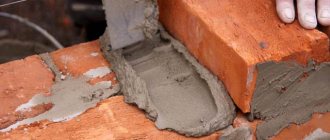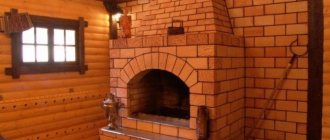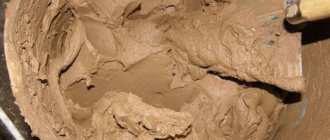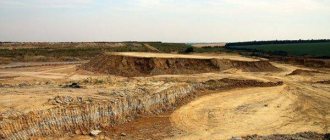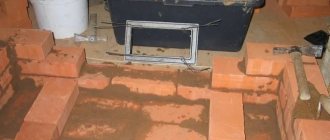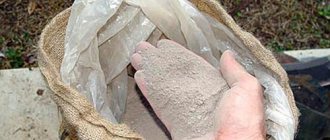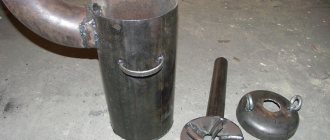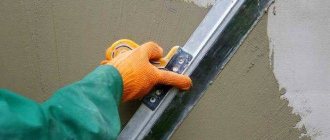What it is
Fireclay is a fire-resistant substance obtained from kaolin. The clay is heated to 1.3-1.5 thousand degrees, as a result of which the mass loses moisture and plasticity. During the process, the material sinteres and changes color from gray to brown. The burned pieces are crushed with special metal shafts to the state of fine sand of different fractions.
As a result of temperature changes, clay characteristics are radically transformed. The result is a very strong raw material, with parameters resembling stone. Due to the loss of liquid, the material does not expand when heated, maintaining its strength. After drying, the finished mixture does not shrink or crack.
Fireproof material Source remokna.in.ua
Fireproof fireclay is a semi-finished product for preparing mortar. By adding certain additives it is easy to adjust the parameters and adjust the mass to the needs of a person. You can find out the material in the store by the letter “Ш” on the packaging. The abbreviation “MSh” or “MP” is present in the names of the ready-to-use composition (mortar). The letter “U” is on a pack of a less strong recycled substance (after secondary processing).
Kaolin clay is classified as a material of natural origin. Raw materials are mined from the bottom of seas, lakes or rivers. The appearance and constituent substances often depend on the location of the deposits. The most common is light gray raw material, there are shades of pink, yellow and blue.
Where are raw materials mined Source teplo.guru
Comparison of factory-made and home-made mixtures, pros and cons
The advantages of ready-made formulations include:
- Fine grinding, careful control of the proportions of the main components.
- The presence of specialized (in some cases, secret) additives, including reinforcing fiber, aluminum oxides and sodium silicates.
- Possibility of purchasing both universal and specialized brands.
- Formation of neat seams, coatings, attractive appearance.
The disadvantages are the high price, the risk of purchasing counterfeits or improperly stored mixtures. When purchasing ready-made mixtures for laying stoves, fireplaces, chimneys, be sure to check the condition of the packaging, the presence of a quality certificate and permission to sell the brand. When constructing Russian stoves or structures with a non-standard configuration, the calculated amount of material may not be enough (not least due to ultra-fine grinding), mixtures are purchased in excess, which again leads to unnecessary expenses. After opening the package, dry ready-made formulations quickly lose their beneficial properties.
“Homemade” mixtures are inferior to factory ones in the accuracy of tracking the quality and proportions of components, but are several times cheaper. Self-kneading pays off:
- With a limited work budget.
- If there is a quarry nearby for the extraction of clay or sand, as well as confidence in their quality.
Career - For low and medium requirements for strength and decorativeness of structures.
Budget fireplace
In most cases, self-prepared mixtures are used in the construction of the main body of the stove; for the firebox and cladding it is worth buying factory-made fireproof plasters and masonry varieties.
Material characteristics
Fireclay clay is produced in powder form, with a fraction of up to 2 mm. If the substance was stored correctly (+15-25 C), then the consistency is homogeneous, without noticeable pieces or lumps. The material loses its properties after 3 years or when kept in damp conditions.
The melting point of all types of fireclay clay is from 1500 to 1850 C. As the degree increases, the performance properties do not change, which allows it to be used in the manufacture of stoves and fireplaces. After sintering, the substance loses its ability to absorb moisture without losing its fire resistance.
Properties of kaolin substance Source proraboff.rf
Kaolin and sand do not have binding capabilities, but when combined, a very strong, dense mass (raw material) is obtained. The strength level of the composition is 12-24 N/sq.mm. Fireclay clay mortar is not inferior in stability to concrete. The product has high adhesive properties, which facilitates subsequent processing.
One package of 20 kg of material is enough to lay 30 bricks. To cover the surface of the cube, use 100 kg of refractory substance. The kaolin composition allows oxygen and moisture to pass through itself, so a favorable microclimate is maintained in the room. Hardened natural fireclay is safe for human health.
Fireclay is a very expensive material with special rules for use. The treated surface takes a long time to dry (3-4 days). If you violate the technology for preparing the solution or do not comply with the exposure time, the mass will not become strong. Fireclay dust rising into the air is toxic, so a respirator with safety glasses is required when mixing ingredients.
Strengths and weaknesses Source yandex.ua
conclusions
The solution for creating fire-resistant masonry is made from certain ingredients. Before work, it is important to check them for quality. This applies to clay and sand. Water should also be free of impurities. The sand must be sifted. As a result of high-quality preparation, durable and fire-resistant masonry can be created from the prepared mortar. Knowing the specifics of choosing materials and mixing the solution, preparing it yourself will not be difficult.
Recommended Posts
Japanese houses made of polystyrene foam
Cement mortar for bricklaying
Gypsum stone for interior decoration + photo
House made of expanded clay concrete blocks + reviews
Polymer concrete: composition, characteristics
How to nail the lining correctly + video
Types of raw materials
Refractory material is the basis from which solutions for various purposes are made. Lump clay is used to create heat-resistant ceramics, bricks and cardboard. The ground type has high characteristics of resistance to fire and strength, which allows it to be used in coating and molding mixtures.
Fireclay is distinguished by the presence of binding additives in its composition. Based on the amount of sand, there are 3 types of raw materials:
- Exhausted. Contains up to 21% of the substance.
- Smooth. The volume of the ingredient varies between 19-48%.
- Binder. Contains 55% loose component.
For a fire-resistant surface, traditional river sand cannot be used in the solution. The substance has a maximum limit of 800 C; at high temperatures it expands, which leads to destruction. Quartz species, kaolin and cement are often used as additives.
Varieties of fireclay clay Source rusboard.net
Stone-like varieties are not used to prepare a solution from fireclay clay. According to the degree of aluminum oxide content, the substance is divided (in percentage) into:
- semi-sour (up to 25);
- basic (26-38);
- highly basic (from 40).
Fireclay powder is divided into 4 grades. Characteristics depend on the degree of fire resistance and the amount of additional ingredients. Numbering from 0 (special) to 3 affects heat resistance and the final cost of the composition.
Cases in which this will be useful to you
In most cases, the need for heat-resistant bricks arises among owners of private houses or summer cottages. Apartment residents do not need it, since fire safety regulations prohibit you from creating an uncontrolled open fire on the territory of a residential building. Alas, building a barbecue on a balcony or loggia is not the best idea.
This type of stone will serve you well when constructing stoves for heating a house, a chimney used for the same purpose, a permanent installation for a grill, or when planning an English fireplace that will show off on the central wall of your future home. It will create comfort and coziness for you, which will add warm and bright colors to your vacation. In addition to all this, don’t forget that on New Year’s Day you will have somewhere to hang festive socks so that Santa Claus will put sweets in them for your children.
It is not worth saving on material, because the quality directly depends on the price, and since buildings made of fireclay bricks are not cheap, their reconstruction will cost a lot of money.
The solution recipe that I will now tell you can also be used for repair work. It is quite possible that one stone may fall off inside the structure, which needs to be put in place using just such a mixture.
Where is it used?
Understanding what fireclay clay is, it is easy to determine the scope of use of raw materials. The powder in solutions is used to create fire-resistant building materials. The substance is used to make strong bricks or clinker tiles. The finish has a high price, so professionals recommend combining it with conventional models.
Using fireclay mortar Source techno-comf.ru
Features of working with ready-made heat-resistant mixtures
Having purchased a heat-resistant mixture for ovens, the first thing you need to do is carefully study the instructions for its use. As a rule, manufacturers recommend carrying out masonry and plastering work at a temperature of at least +5 degrees. To store the sealed substance, you need to choose a warm, dry room. Even in the store, the packaging is carefully inspected for damage that could cause a violation of the required proportions of the various components.
The most common proportion when preparing the finished solution is to dilute 1 kg of dry powder in 0.27 liters of clean water. If we are talking about masonry work, then before carrying out it, it is recommended to soak the bricks in water in advance: thanks to this simple procedure, it is possible to significantly increase the strength of the masonry.
How to use it correctly
The basis of the composition is clay powder and water in the required proportion. During the production of fireclay, kaolin loses its plasticity. To restore the pliability and elasticity of the mixture, special additives are added to the composition. For each task, there are rules that allow you to obtain a strong fire-resistant material.
For laying the furnace
Plasticity indicators are often improved with kaolin sand. The white substance is sold in construction stores in bags. In one container, clay is mixed with the additive in proportions of 4 to 1, then water is slowly poured in small portions. To obtain a uniform consistency, professionals recommend using a special mixer.
In order for the ingredients to reveal their characteristics, the preparation is left for 3 days. The finished mixture resembles plasticine in thickness. The solution should not stick or flow easily, and there should be no lumps under your fingers. If you scoop it up with a trowel, the mass slowly slides off, without leaving a residual mark.
Features of technology for the stove Source stroyfora.ru
The presence of clay components is called fat content. The parameter is responsible for the plasticity of the finished material. You can increase or decrease the characteristic using sand or fireclay. Oversaturated solutions do not affect the quality of the stove, but due to “lean” options, the structure will crumble.
To find out the fat content of clay at home, you need to roll a ball from the finished raw materials. The samples are pressed down on top with a long board. If cracks appeared under low pressure, then the solution is “lean”. If ruptures occur at half the radius of the ball, it indicates high plasticity indicators, and at a third – average (normal). The last two types are suitable for construction work.
The surface to be treated must be prepared. The old finish is removed from the wall and the reinforcing mesh is fixed. In order for the product to hold tightly, a layer of solution must be applied on top. Knowing how long fireclay clay takes to dry, you can begin laying out the stove in 3-4 days.
The classic stove mixture consists of base material and sand. An experienced master uses at least 3 types of solution with different additives when working. Cement-lime varieties are recommended for the base and chimney. When assembling the frame, cement is added to the composition; for the combustion chamber, red clay is added.
Rules for using chamotte Source vbud.in.ua
Self-preparation of refractory mortar
To prepare a refractory mixture for a stove, you need to dig up or purchase raw clay. It is this type of material that has the necessary qualities to prevent shrinkage of assembly seams. To prevent clay from crumbling, it is reinforced with cement and sand (2 parts clay, 0.3 parts cement and one part sand).
It is also important to check the saturation of the clay. To do this, it must be kneaded in water to a plastic state, forming a ball with a diameter of about 5 cm from the resulting mass. It is placed between two boards, which are gradually shifted by pressing on the ball. A normal concentration of material will crack when the lump shrinks 1/3. An earlier appearance of cracks will indicate a lack of fat content in the clay, and a later appearance will indicate an excess of it. Clay with low fat content is usually rejected. Excessively fatty material is additionally diluted with sand.
How long does clay mixture take to harden?
The time for complete drying of fireclay paste in air is 72 hours, inside the brickwork this time increases, it depends on the thickness of the masonry, temperature and humidity of the surrounding air. Petrification of fireclay mortar occurs at 800 degrees Celsius.
Important! Fireclay masonry does not like sudden changes in temperature. The stove is heated for the first time three days after completion of construction.
Use thin, quickly burning logs. The dampers and vents are fully opened during the first fire. Then the stove is dried for a week, burning small portions of wood daily
The furnace is heated for the first time three days after construction is completed. Use thin, quickly burning logs. The dampers and vents are fully opened during the first fire. Then the stove is dried for a week, burning small portions of wood daily.
Fireclay masonry dries faster than masonry made from ordinary clay-sand mortar and ceramic bricks, but only the firebox is usually made of fireclay. Therefore, the timing of the start of operation of a furnace with fireclay masonry will be the same as the timing of use of a furnace built on clay and lime mortar. In summer, a new stove is heated to maximum after 10-14 days, in winter - after a month.
Possible consequences
Certain errors, of course, are acceptable, but a disregard for the production of a special heat-resistant solution leads to catastrophic consequences. Improper mixing can cause severe cracks or complete looseness of the brick-to-brick connector. Subsequently, you will see how the entire structure deforms and collapses right before your eyes.
Quite a large number of owners of stoves, pipes, barbecues and grills, built by irresponsible, disgusting craftsmen, asked for help. But all we could do was disassemble and reassemble the entire structure.
It was unbearably painful to see the look of a man who had already marinated the meat and realized that he would have to fry it over a regular fire. It became even worse at the moment when he turned his head, and part of the chimney collapsed inside the built fireplace. It was doubly offensive because it was not Santa Claus who broke it.
A little personal experience
Friends, I have repeatedly worked with the construction of elements that were later used for heating with wood. Based on my experience, the biggest mistake that owners make is saving money. I was glad that they did not decide to save money on professionals, but I was very disappointed in the quality of the materials they purchased.
All work related to the construction of heat-resistant elements can be done with your own hands. It’s better to save your money and don’t overpay to expensive builders, but you can’t skimp on fireclay bricks and fireclay. No matter how cool the master is, he will not be able to make candy from underground raw materials. You can blame him later, but I am sure that you will be warned about this outcome of events.
Friends, remember my advice and save your savings by saving on the right things, and not on those that you vitally need! Warmth, comfort and speedy completion of the renovation!
Use for plastering
In this case, the solution is prepared a little differently. Its composition should be like this:
- Portland cement – 1 hour;
- fireclay clay – 2 hours;
- quarry sand – 7 hours.
Water is added in such an amount that the finished solution acquires the consistency of sour cream. Since baked clay has much less plasticity than ordinary clay, the plaster layer of it must be strengthened using a special metal mesh. The solution is applied in the usual way - using a spatula.
